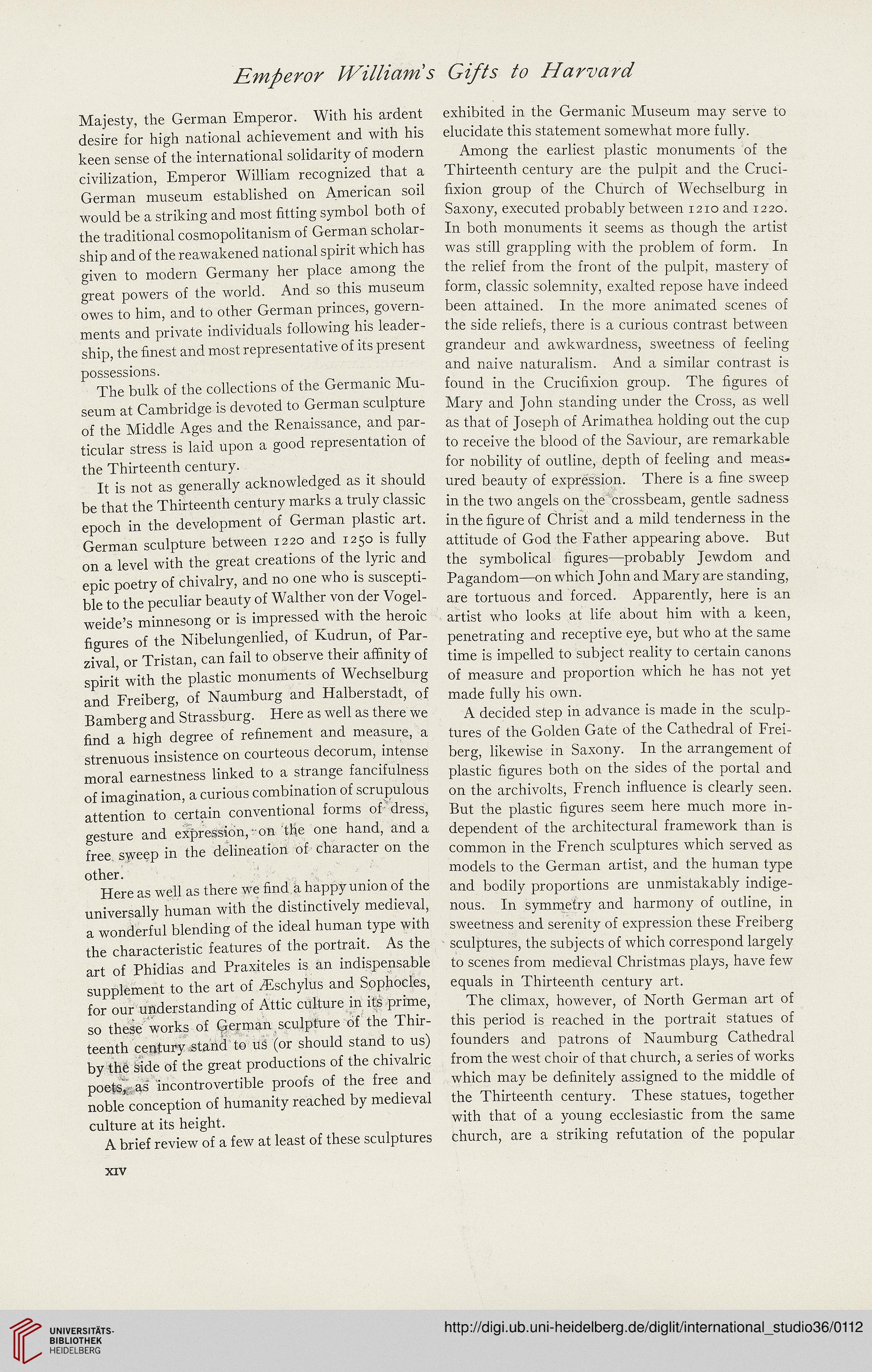Majesty, the German Emperor. With his ardent
desire for high national achievement and with his
keen sense of the international solidarity of modern
civilization, Emperor William recognized that a
German museum established on American soil
would be a striking and most fitting symbol both of
the traditional cosmopolitanism of German scholar-
ship and of the reawakened national spirit which has
given to modern Germany her place among the
great powers of the world. And so this museum
owes to him, and to other German princes, govern-
ments and private individuals following his leader-
ship, the hnest and most representative of its present
possessions.
The bulk of the collections of the Germanic Mu-
seum at Cambridge is devoted to German sculpture
of the Middle Ages and the Renaissance, and par-
ticular stress is laid upon a good representation of
the Thirteenth century.
It is not as generally acknowledged as it should
be that the Thirteenth century marks a truly classic
epoch in the development of German plastic art.
German sculpture between 1220 and 1250 is fully
on a level with the great creations of the lyric and
epic poetry of chivalry, and no one who is suscepti-
ble to the peculiar beauty of Walther von der Vogel-
weide's minnesong or is impressed with the heroic
figures of the Nibelungenlied, of Kudrun, of Par-
zival, or Tristan, can fail to observe their athnity of
spirit with the plastic monuments of Wechselburg
and Freiberg, of Naumburg and Halberstadt, of
Bamberg and Strassburg. Here as well as there we
hnd a high degree of refinement and measure, a
strenuous insistence on courteous decorum, intense
moral earnestness linked to a strange fancifulness
of imagination, a curious combination of scrupulous
attention to certain conventional forms of dress,
gesture and ekpression, * on 'the one hand, and a
free syveep in the delineation of character on the
other.
Here as well as there we hnd a happy union of the
universally human with the distinctively medieval,
a wonderful blending of the ideal human type with
the characteristic features of the portrait. As the
art of Phidias and Praxiteles is an indispensable
supplement to the art of yEschylus and Sophoeles,
for our understanding of Attic culture in its prime,
so these works of (lerman sculpture of the Thir-
teenth ceqtury stand to ug (or should stand to us)
by thd kide of the great productions of the chivalric
poets, as' incontrovertible proofs of the free and
noble conception of humanity reached by medieval
culture at its height.
A brief review of a few at least of these sculptures
exhibited in the Germanic Museum may serve to
elucidate this statement somewhat more fully.
Among the earliest plastic monuments of the
Thirteenth century are the pulpit and the Cruci-
fixion group of the Church of Wechselburg in
Saxony, executed probably between 1210 and 1220.
In both monuments it seems as though the artist
was still grappling with the problem of form. In
the relief from the front of the pulpit, mastery of
form, classic solemnity, exalted repose have indeed
been attained. In the more animated scenes of
the side reliefs, there is a curious contrast between
grandeur and awkwardness, sweetness of feeling
and naive naturalism. And a similar contrast is
found in the Crucihxion group. The figures of
Mary and John standing under the Cross, as wel]
as that of Joseph of Arimathea holding out the cup
to receive the blood of the Saviour, are remarkable
for nobility of outline, depth of feeling and meas-
ured beauty of expression. There is a fine sweep
in the two angels on the crossbeam, gentle sadness
in the figure of Christ and a mild tenderness in the
attitude of God the Father appearing above. But
the symbolical hgures—probably Jewdom and
Pagandom—on which John and Mary are standing,
are tortuous and forced. Apparently, here is an
artist who looks at life about him with a keen,
penetrating and receptive eye, but who at the same
time is impelled to subject reality to certain canons
of measure and proportion which he has not yet
made fully his own.
A decided step in advance is made in the sculp-
tures of the Golden Gate of the Cathedral of Frei-
berg, likewise in Saxony. In the arrangement of
plastic hgures both on the sides of the portal and
on the archivolts, French induence is clearly seen.
But the plastic hgures seem here much more in-
dependent of the architectural framework than is
common in the French sculptures which served as
models to the German artist, and the human type
and bodily proportions are unmistakably indige-
nous. In symmetry and harmony of outline, in
sweetness and serenity of expression these Freiberg
sculptures, the subjects of which correspond largely
to scenes from medieval Christmas plays, have few
equals in Thirteenth century art.
The climax, however, of North German art of
this period is reached in the portrait statues of
founders and patrons of Naumburg Cathedral
from the west choir of that church, a series of works
which may be dehnitely assigned to the middle of
the Thirteenth century. These statues, together
with that of a young ecclesiastic from the same
church, are a striking refutation of the popular
xrv





